The old saying that “everyone talks about the weather” is certainly true when it involves landscape plant managers. Professional landscapers/arborists and their clients are always discussing how various weather factors are affecting plants. The New Jersey weather trends can often be variable from one growing season to the next. How do rain, wind and temperature changes impact plants and their corresponding insect/mite pests?
The chart below lists four weather conditions & categorizes how these conditions positively or negatively influence some of the key landscape insect/mite pests.
TABLE: PESTS AFFECTED BY SPECIFIC CONDITIONS (Source: David Shetlar, Ohio State Cooperative Extension)
| “A” Hot-Dry Weather Pests | “B” Cool Weather Pests | “C” Pests Damaged by Excessive Rains | “D” Pests Attracted to Stressed Plants |
|
-Lace Bugs -Scales -Leaf Beetles -Caterpillars -Warm Season Mites
|
-Aphids (some)
-Adelgids -Root Weevils -Cool Season Mites -Eriophyid Mites (some)
|
-Lace Bugs (fungus)
-Aphids/Mites (impact) -Scale Crawlers (impact/wind) -Caterpillars (fungus) -Black Vine Weevils fungus) |
-Aphids (some)
-Scales (some) -Whiteflies -Caterpillars (some) -BORERS!! |

Hawthorn Lace Bug signs showing adult, late instar & fecal “tar spots” at leaf underside. (Photo Credit: Steven K. Rettke, Rutgers Coop. Ext.)
Hot-Dry Weather Pests: Some of the common landscape pests that are most active in Hot-Dry conditions are listed in the Table within column “A.” It is well their known that lace bugs reach highest populations on plants located in sunny-dry locations. There are few predators in these areas, and the shallow root systems of plants such as azaleas, rhododendrons & andromeda are often under drought stress. Lace bugs typically thrive under these conditions.
Scale insects also generally will do better in hot-dry weather primarily because the immatures are not knocked off the plants by raindrop “bombs.” Recently hatched scale crawlers are unprotected for a few days as they move about the plant looking for a place to settle down. If rains do cause the crawlers to fall to the ground, it is unlikely they will be able to climb back up the plant before they die (their short-stubby legs do not work very well). The timing of the rainfall to suppress the scale crawlers is critical because they typically are active for only a few days. Once they settle down and insert their mouthparts into the plant tissue, they are less vulnerable to the raindrops.
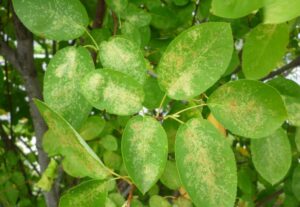
Hawthorne Lace Bug stippling symptoms on young serviceberry leaves. This species overwinters as adults. (Photo Credit: Steven K. Rettke, Rutgers Coop. Ext.)

Euonymus scale crawlers can easily be knocked-off plants by raindrop impacts. (Photo Credit: Steven K. Rettke, Rutgers Coop. Ext.)
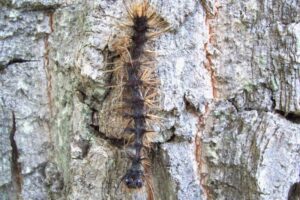
This dead spongy moth caterpillar was killed by the Entomophaga fungus. This fungus is most viable during cool, moist springs. (Photo Credit: Steven K. Rettke, Rutgers Coop. Ext.)
Various leaf beetles and caterpillars usually prefer hot-dry conditions not because they may get knocked off the plants (they will often simply climb back up), but since they can be infected by fungal diseases if a lot of free moisture is present. For example, the Entomophaga fungus has been decimating most of the spongy moth (formerly “gypsy moth”) populations for several decades. Most often it does an excellent job of keeping these caterpillar populations in check in cool, moist springs. However, when warm and dry springs occur, this pest typically returns to become a problem again in certain areas.
One of the most common of the warm season pests is the two-spotted spider mite. These pests thrive in very dry conditions, and they will reproduce more rapidly when it is warmer. Mites are vulnerable to being dislodged by heavy rains unless they are under protective leaf covering. Invariably, the worst spider mite populations within the landscape occur when plants are sited under over-hanging structures. In the landscape, two-spotted spider mites can have between 10 to 15 generations per year.
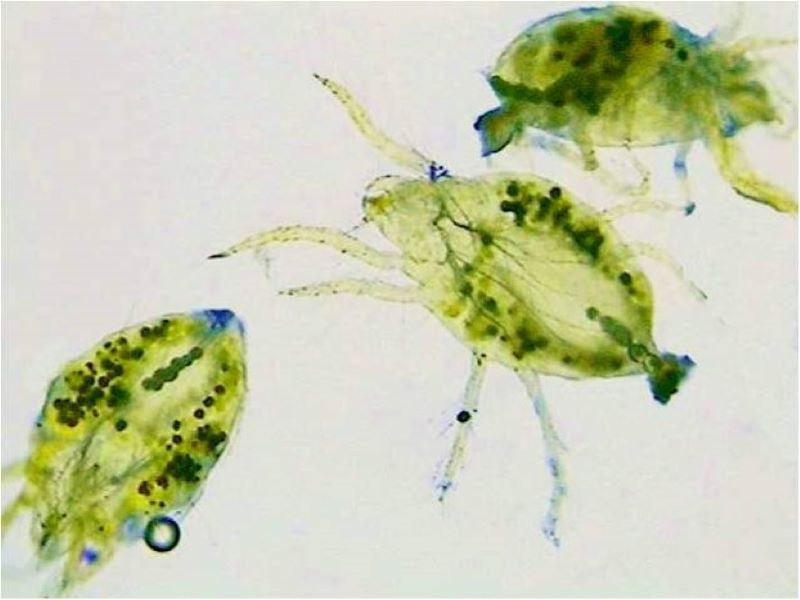
Two-Spotted Spider Mite adults showing the prominent dark spots composed of digesting plant material on each side of the body. As the mites feed & age, the spots become more pronounced. (Photo Credit: James Willmott, former Agricultural Agent, Rutgers Coop. Ext.)

When a burning bush is defoliated by two-spotted spider mites in mid-summer it will not have the bright red colored leaves during the fall. (Photo Credit: Steven K. Rettke, Rutgers Coop. Ext.)
Cool Weather Pests: The insects listed within column “B” in the Table are some of the common landscape pests most active during cool weather. Many aphids are the earliest insects noticed in the spring, feeding on new, soft, and succulent plant growth. Additionally, some species of aphids are more active in the cooler weather to avoid predation (many common beneficial insects (i.e., lady beetles and lacewings perform best during the summer months). Some of these aphid species will disappear when warmer weather persists but will return the following fall season as the cooler conditions develop again.

Aphids are often plentiful on the early spring plant growth. In the landscape, aphids are often thought of as “junior varsity pests.” Damage to most plants is usually mild. (Photo Credit: Steven K. Rettke, Rutgers Coop. Ext.)
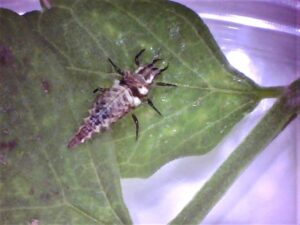
Hot, dry locations will usually have fewer predators such as parasitoids or green lacewing larvae as shown above. (Photo Credit: Steven K. Rettke, Rutgers Coop. Ext.)
Most of the adelgids will do well in cool weather. The immature spruce gall adelgids, for example, overwinter on the terminal buds and are not adversely affected by extremely cold temperatures. Also, pine bark adelgids seem to have their greatest populations on those pines that are in shaded locations. Often, a mass planting of pines too closely spaced in the landscape will have these adelgids infested on the interior stems or branches of trees.
The root weevil grubs (e.g., black vine weevils) prefer cool-moist conditions within the soil. If the soils become too wet, however, they become susceptible to fungal and bacterial infections. The larvae will often be forced to feed higher up the stem of the plant, where it is not as wet. This may cause the stem to be girdled, causing death to the plant.

Pine Bark Adelgids will often proliferate within cooler, shady conditions at the interior of a tree. (Photo Credit: Steven K. Rettke, Rutgers Coop. Ext.)
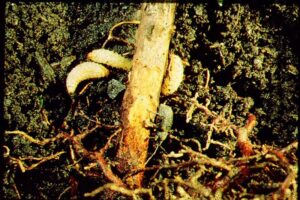
Black Vine Weevil adults & larvae will feed higher-up on the plant stem to avoid wet soils & fungal infections. (Photo Credit: Ohio State Coop. Ext.)

Spruce Spider Mite feeding symptoms on previous year growth. New year growth will remain green throughout the summer. (Photo Credit: Steven K. Rettke, Rutgers Coop. Ext.)
The cool season mites, such as the spruce spider mite, are happiest when temperatures are 60° F. or less. During the late spring, populations can explode, and webbing may be highly noticeable. By summer, conifer foliage damaged by mites during the spring often desiccates, turning the inner needles from yellow to brown or orange in color. Only newer present year growth remains green.
Come the hot summer months, spruce spider mites usually become inactive (However, if the daily high temperatures remain consistently below 85° F. for extended periods of time, then spruce spider mites may continue activity). These cool season mites begin to rebuild their populations in September and reach their peak in November. The last active spruce mites may be present into the month of December, and the overwintering eggs are not laid until nighttime temperatures consistently drop below freezing. Spruce spider mites can have between 7 to 10 generations per year.

The uniform bronze discoloration of bald cypress needles from eriophyid mites. They require magnification to observe. (Photo Credit: Steven K. Rettke, Rutgers Coop. Ext.)
Some of the eriophyid mites, such as the hemlock rust mite, are adapted to temperatures even colder than the spruce spider mite. They may begin activity as early as late-February in some situations. Look for them on the sunny side of conifers during late winter weeks. These eriophyid mites are only one-third the size of spruce spider mites. Therefore they are just 1/150th of an inch in size. Other species of eriophyid mites are adapted to warmer weather such as the bald cypress mite shown in the photo at right.
Insects/Mites Damaged by Excessive Rains: The insects and mites listed within column “C” in the Table are some of the pests that may be adversely affected by excessive rains. These pests have already been discussed in the above sections. Rain can be detrimental to pest survival and proliferation because of the insect disease fungus it promotes, as well as the physical impact it causes (direct kill). Spider mites & scale crawlers are two of the best examples of how rain negatively affect pest populations.

Pine Needle Scale Crawlers are vulnerable to being knocked-off needles from raindrop impacts. This scale species has two generations per year & crawlers will be active in May & July. (Photo Credit: Ohio State Coop. Ext.)

The two-spotted spider mite species produces the greatest quantity of webbing of any spider mite species within the landscape. However, they are still negatively affected by rain despite the protection. (Photo Credit: Steven K. Rettke, Rutgers Coop. Ext.)
Stressed Plant Pests: The insects listed in column “D” are examples of pests that are attracted to plants under stress. Aphids and whiteflies are drawn to plants with yellowing foliage. Plants under stress often lose some of their chlorophyll and become yellowish in color. Yellow sticky cards are often hung in greenhouses to monitor for some of these pests.

Spongy Moths (formerly “gypsy moths”) are less selective feeders & can successfully digest numerous toxins from many different plant hosts. (Photo Credit: Steven K. Rettke, Rutgers Coop. Ext.)
Some species of caterpillars (not gypsy moth) are “samplers” when they feed. These caterpillars will sample individual leaves to determine if they contain plant defensive chemicals such as tannins or alkaloid toxins. If these toxins are contained within the leaves, the caterpillar may find it distasteful and move on to sample other leaves. A weakened plant under stress may not have enough energy to produce these defensive chemicals and therefore, be more attractive for these caterpillars.
The greatest concern with stressed plants in the landscape is from borer infestations. The best examples of borer-prone plants are when drought conditions and elevated temperatures stress non-native plants. Pine bark beetles, bronze birch borers, and the two-lined chestnut borers are all encouraged when stressed tress are forced to “shut-down” their vascular systems (xylem & phloem tissues). When trees have low sap pressure, the borers can easily penetrate and cut through vascular tissue. Furthermore, trees with compromised vascular systems cannot readily transport defensive chemicals to areas invaded by borers.

Pine Bark Beetles are attracted to stressed pines & will often be the “final straw” that kills the tree. (Photo Credit: Steven K. Rettke, Rutgers Coop. Ext.)

Stressed trees (especially drought stress) are attractive to wood borers that tunnel under the bark & destroy the tree’s vascular tissues. (Photo Credit: Steven K. Rettke, Rutgers Coop. Ext.)

